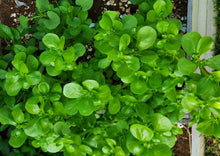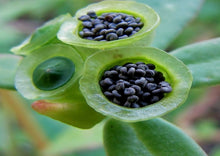Heirloom Golden Purslane is a unique and nutritious leafy green vegetable that has a long history of cultivation. Originally from the Mediterranean region, this ancient vegetable has been enjoyed for centuries by people all over the world. The "heirloom" designation means that this particular variety of purslane has been passed down through generations, preserving its unique characteristics and flavor.
Golden Purslane is known for its vibrant yellow leaves and its high nutritional value. It is a rich source of Omega-3 fatty acids, Vitamin A, Vitamin C, Vitamin E, and Vitamin K. It also contains a significant amount of minerals such as calcium, potassium, and magnesium. It has a slightly lemony taste and a slightly succulent texture making it a perfect addition to salads, sandwiches, and as a garnish.
The Golden Purslane plant is a low-growing, succulent plant with small, round leaves and yellow flowers. It can grow up to 6 inches tall and it has a spreading habit. It is a hardy plant that can grow in a variety of conditions and can be found in gardens, meadows, and even cracks in sidewalks.
The entire plant, including the leaves, stems, flowers, and seeds are edible and have been used for thousands of years in different variations.
Seed Description
Tiny purslane seeds develop inside seedpods in spring and early summer. The pods grow close to the stem in a cone shape. When ripe, the top of the cone breaks off and the seeds scatter naturally. Purslane seeds are slightly oval, black and wrinkled. If you look closely, you can see a white marking on one end of the seed. To collect purslane seeds, cut the seedpods from the plants before the seeds scatter.
Seed Germination
Purslane seeds take seven to 10 days to germinate between 70 and 90 degrees Fahrenheit. You can sow seeds 1/4 to 1/2 inches deep directly in the garden. Spring is the best time to plant purslane from seed. In areas with even mild frost in winter, wait until the last frost date has passed and the soil has warmed to at least 70 F before planting. In mild, frost-free climates, you can plant in late winter as long as the soil temperature is high enough for germination to occur.
Care
Fertilizing
Purslane can grow successfully without fertilizer but applying a water-soluble 20-20-20 fertilizer to your purslane weekly encourages healthy growth and flower production. A solution of 2 tablespoons of 20-20-20 dissolved in 1 gallon of water provides enough fertilizer to treat 4 square feet of garden bed. Check the package instructions because rates vary by brand.
Growing and Harvest
The only conditions that purslane does not thrive in are heavy, wet or waterlogged soil and freezing conditions during the growing season. Purslane grows well in rocky soil, is drought tolerant can withstand full sun or deep shade and grows voraciously in loamy garden soil. Harvest whole plants by pulling them from the soil during spring for use as a fresh or cooked green vegetable. You can eat the leaves and stems by picking them individually from the plant throughout the growing season.
Control
While edible and grown as a vegetable, purslane is also considered an invasive, nonnative species. The best way to control purslane is by cutting the flowers off before the plants set seed. You can also dig the plants from the garden to remove them, but make sure not to leave any roots or stem fragments behind to grow into new plants. Do not till a purslane patch; it will come back with a vengeance and be difficult to eradicate. To help control purslane, grow it in containers and carefully remove the flowers before seeds develop.
Pests / Diseases
Purslane is a vigorous plant rarely affected by diseases or pests except for purslane sawfly and the portulaca leaf-mining weevil. The larval form of purslane sawfly looks like a caterpillar and can be picked off of the plants by hand. Severe infestations of these pests can kill the purslane. Adult sawflies emerge from the soil in late spring and lay several batches of eggs during the summer. Portulaca leaf-mining weevils are grub like in appearance and burrow into the leaves of purslane, visible below the leaf's surface. Checking your plants regularly and removing pests or infested leaves when you see them is the best way to control these pests. Natural ways of Insect Control: Strong spray of water, add 2 - 4 drops of oil of neem oil in a gallon water and spray, add 1 drop of natural soap and 1 teaspoon of vegetable oil in a gallon water and spray.
Click here to download our free vegetable growing guide
Heirloom, Golden Purslane, Mediterranean, Ancient vegetable, Nutritious, Leafy green, Omega-3, Vitamin A, Vitamin C, Vitamin E, Vitamin K, Calcium, Potassium, Magnesium, Lemony taste, Succulent, Salads, Sandwiches, Garnish, Low-growing, Hardiness, Medicinal properties, Inflammation, Digestion; Indian vegetable seeds; Best indian vegetable seeds in USA; Top vegetable seeds for USA climate; Organic vegetable seeds India; High yield vegetable seeds India; Popular vegetable seeds in India, Heirloom Indian vegetable seeds USA; Vegetable seeds for home gardening USA; Traditional Indian vegetable seeds; Non-GMO vegetable seeds USA; Vegetable seeds for balcony gardening India; High-quality indian vegetable seeds USA; Vegetable seeds for urban farming USA; Seed companies in India; Best vegetable seeds for Indian kitchen garden; Fast-growing vegetable seeds India; Vegetable seeds for all seasons India; Best vegetable seeds for hydroponic gardening India; Vegetable seeds for beginner gardeners India and USA; Rare vegetable seeds India; Affordable vegetable seeds India; Imported vegetable seeds India; Native Indian vegetable seeds; Open-pollinated vegetable seeds India.






